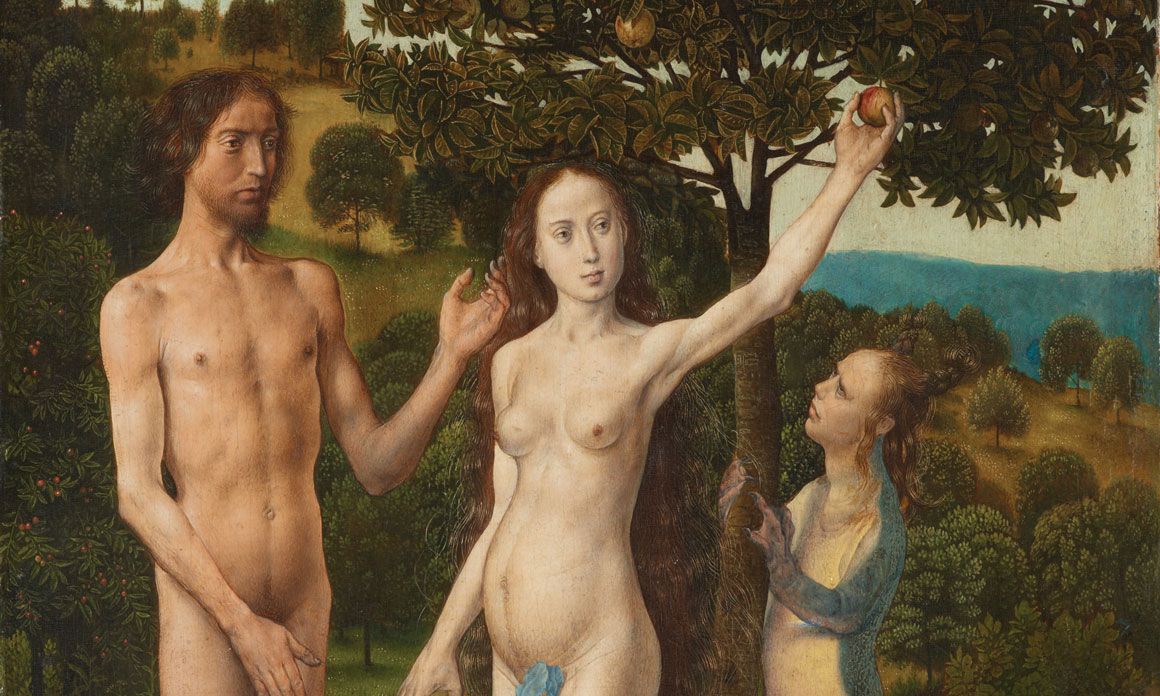The Fall of Man panel from Hugo van der Goes's Vienna Diptych (around 1477-79) Kunsthistorischesmuseum
The 15th century’s Netherlandish painters created a new kind of realism by figuring out how to use the newly refined oil technique to render effects of light. Their advances made their way south to Italy, altering the course of the Renaissance, but the artists themselves largely drifted into obscurity. Rediscovered in the 19th century, and a subject of endless fascination for the founders of the new discipline of art history, revered figures such as Jan van Eyck, Rogier van der Weyden and Hugo van der Goes remain objects of close study and scholarly debate.
Van Eyck and Van der Weyden have each had substantial shows in the past decade. Now it is the turn of Van der Goes, the creator of the Portinari Altarpiece—arguably the most important northern European work in the Uffizi Gallery—whose imposing size and epic clarity astonished quattrocento Florence when it arrived in the city in 1483. Van der Goes had died the year before in a mysterious state of madness. This month, Berlin’s Gemäldegalerie will mount the artist’s very first monographic show.
Visitors to the Gemäldegalerie exhibition will get the opportunity to compare Van der Goes’s monumental Monforte Altarpiece (around 1470), left, with his small-scale Vienna Diptych (around 1479) Courtesy of Staatliche Museen zu Berlin, Gemäldegalerie. Photo: Dietmar Gunne
Hugo van der Goes: Between Pain and Bliss brings together ten of the 12 paintings now attributed to the artist, as well as the two agreed-upon drawings. Scholars will have a unique opportunity to view Berlin’s own monumental Van der Goes work, the Magi scene of the Monforte Altarpiece (around 1470), with the small-scale Vienna Diptych (around 1479), whose Fall of Man panel shows Van Eyck’s influence alongside the Van der Weyden-like Lamentation.
The curators will then consider his place in the history of Western art with around 50 additional works by predecessors like Van der Weyden and Dieric Bouts, as well as a host of Van der Goes followers. The Uffizi triptych and the Trinity Altarpiece (1478-79), at the Scottish National Gallery, are too fragile to travel and will be included as life-size photos. Lost works, such as a second treatment of the Adoration of the Magi, will be recalled with near-contemporaneous copies.
Van der Goes's recently restored Death of the Virgin (around 1480) Groeningemuseum
With Van Eyck and Van der Weyden, the main topic of dispute is attribution; with Van der Goes, it is chronology. In a working life that lasted little more than a decade, he created several large-scale and diverse masterpieces, first in a Ghent workshop, and then from a thriving workshop inside a monastery near Brussels, where he entered as a lay brother in what scholars believe must have been between 1475-77.
The curators argue, for example, that the Portinari Altarpiece was made somewhat later than some other scholars assert, citing the theory that the wooden supports of the Uffizi work were executed in the same carpentry workshop as the late Berlin and Bruges works. This suggests that, though the altarpiece may have been planned in Ghent, it was — crucially — executed inside the monastery.
Émile Wauters's The Madness of Hugo van der Goes (1872) © MRBAB, Brussels, photo: J. Geleyns; Royal Museums of Fine Arts Belgium
Much academic study of Van der Goes has been marked by an early 16th-century account of his strange depression and apparent suicide attempt, uncovered in the 1860s, and then depicted in an acclaimed 1872 Belgian history painting by Émile Wauters called The Madness of Hugo van der Goes. That work, which fascinated Vincent van Gogh, will also be on view in Berlin.
“Whether a painting was made in 1470 or 1480 does not matter much,” says the co-curator Stephan Kemperdick. “But in the case of Hugo van der Goes, it does, because people search for traces of madness in his work.” No less a figure than the great German historian Erwin Panofsky saw hints of insanity in what are believed to be the late works, such as Berlin’s own Nativity (around 1480) and the fabulously coloured, recently restored Death of the Virgin (around 1480), on loan from Bruges. However, the show’s curators counter previous suggestions: “Hugo didn’t paint anything after he fell ill,” Kemperdick says. What is certain is that we are finally beginning to see wider recognition of the achievements of Van der Goes.
• Hugo van der Goes: Between Pain and Bliss, Gemäldegalerie, Berlin, 31 March-16 July

